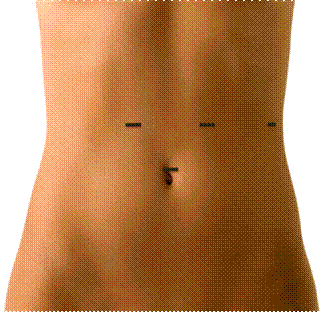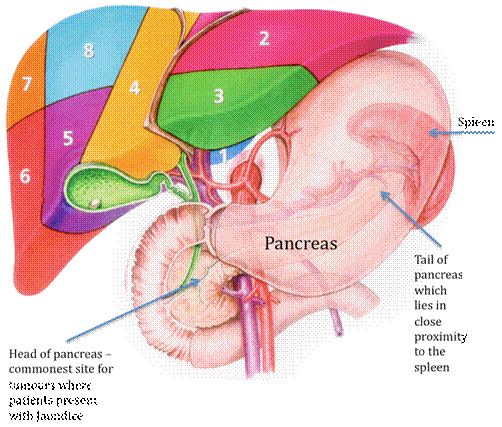Pancreatic Cancer
What is the pancreas?
The pancreas is a spongy organ approximately 12-15cm in length and lies behind the stomach (see diagram below). The pancreas consists of a head, neck, body, tail and also a portion below the head called the uncinate process. The main function of the pancreas is the production of the hormone insulin, which controls blood sugar levels known as its endocrine function. Also the production of pancreatic juices, which pass through the main pancreas duct into the small intestine to digest food products its exocrine function.
What is pancreas cancer?
Pancreatic cancer is the sixth most common cancer in the U.K. Like any cancer its true cause is unknown, but the chance of it developing increases with increasing age and also with patients that drink excessive amounts of alcohol over many years. Pancreas cancer is also two to three times more common in smokers.
How does Pancreas Cancer present?
Pancreas Cancer presents commonly with symptoms described as:
'Painless, obstructive jaundice', 'weight loss', 'poor appetite'
Pancreas cancer has no specific symptoms, presenting with little or no pain in most patients. Some patients describe a feeling of abdominal discomfort, but most patients eventually notice a change in colour of the white of their eyes (sclera) to a yellow tinge - jaundice. Jaundice is associated with very dark urine (tea without milk) and pale stools (yellow/grey or clay coloured floating foul smelling stool). Other symptoms are typical of a suspected malignancy, such as weight loss, poor appetite and general deterioration in health. Occasionally patients can also complain of back pain, this can occur with tumours located to the body or tail of the pancreas.
How is pancreas cancer diagnosed?
The diagnosis of pancreatic cancer is made following a careful consultation with your specialist surgeon who will examine you and order certain specialised blood tests. Computer Tomography (CAT) scanning forms an important part of diagnosing pancreas cancer by providing detailed pictures/ images. Magnetic Resonance Scan (MR) can also be used. Further more sensitive imaging modalities are also now employed more routinely such as Endoscopic Ultrasound Scan (EUS) and Endoscopic retrograde cholangiopancreatography ERCP.
ERCP, is a special x-ray of the common bile duct (see diagram). Similar to gastroscopy, a flexible tube (endoscope) is passed down the patient's throat through the stomach and into the duodenum (small intestine). Pictures on x-ray of the common bile duct and pancreas duct can be taken by injecting a dye into the ducts.
EUS is a procedure that allows careful examination of the pancreas and is very accurate at diagnosing pancreatic cancer. As for ERCP an endoscope is passed with EUS having a special adapted ultrasound probe on the end, which scans the pancreas for cancers and is able to take biopsies. This procedure is especially useful for examining smaller cancers that may not be picked up by a CAT scan.
What are the common types of Pancreas Cancer?
Types of Pancreas cancer include:
1) Adenocarcinoma (commonest)
2) Neuroendocrine tumour
3) Cystic tumours
4) MEN Syndromes
5) Gastrinomas, Insulinomas
The large majority of diagnosed pancreatic cancers are not amenable to surgical treatment, which is preferred when possible. Surgery is offered dependant upon the locality of the tumour and the fitness of the patient to undergo major surgery.
How can pancreas cancer be treated?
Pancreas cancer's treatment depends on factors such on its size, location on the pancreas (head, body, neck, tail) and evidence of any spread of the cancer. Complete removal of the cancer by surgery is the best and recommended treatment, with other possible treatments including chemotherapy and radiotherapy.
What Surgery is involved?
Head of pancreatic tumours are removed by a procedure called a Whipple's Pancreaticoduodenectomy. This is major surgery, which involves removing the head of the pancreas along with part of the bile duct, stomach and duodenum. The remaining pancreas, bile duct and stomach are reconstructed using the small bowel. Patients are in hospital for a minimum of two weeks with complete recovery taking at least a further four to six weeks. Immediately following surgery for the first 24 to 48 hours patients are managed on the progressive care unit with transfer to their private room for the remainder of their stay.
Laparoscopic Pancreatic Surgery
Laparoscopic 'keyhole' surgery is offered to patients with a pancreatic tumour or cysts on the tail of the pancreas. This surgery allows for quicker recovery however, it is only possible in selected cases. The surgery involves the use of four or sometime five small 1-2cm incisions as shown below. The tail of the pancreas is removed through the belly button wound using a small bag.
Effects of Laparoscopic Distal Pancreatectomy
All patients are warned that the spleen as it lies in close proximity to the tail of the pancreas in some cases needs to be removed (see diagram below). The cells that control blood sugar levels predominantly lie on the tail of the pancreas. Hence once the tail of the pancreas has been removed some patients can become insulin resistant, or diabetic following surgery. Laparoscopic pancreatic surgery does lead to quicker recovery with most patients being discharged in 5-7 days.
Incisions used for Laparoscopic Distal Pancreatectomy

What are the effects of Open Pancreas Surgery?
Following a Whipple's, patients do take time to recover, with a return to normal eating taking in some cases at least one to two months. Patients often lose weight and can complain of persistent nausea after surgery. Regaining a good intake of adequate diet and fluids as well as good wound care are the mainstay of follow up care for patients undergoing surgery for pancreas cancer.
Do all patients have Surgery? - Non-Surgical Treatment
Unfortunately not all patients are able to undergo surgery for pancreas cancer. Therefore excellent support for patients is required for the relief of Jaundice, pain control, Oncology and Palliative care support. Patients as well as their families have access to all the care this service provides. Chemotherapy forms the mainstay of treatment of patients with pancreas cancer.
Diagram of Pancreas
